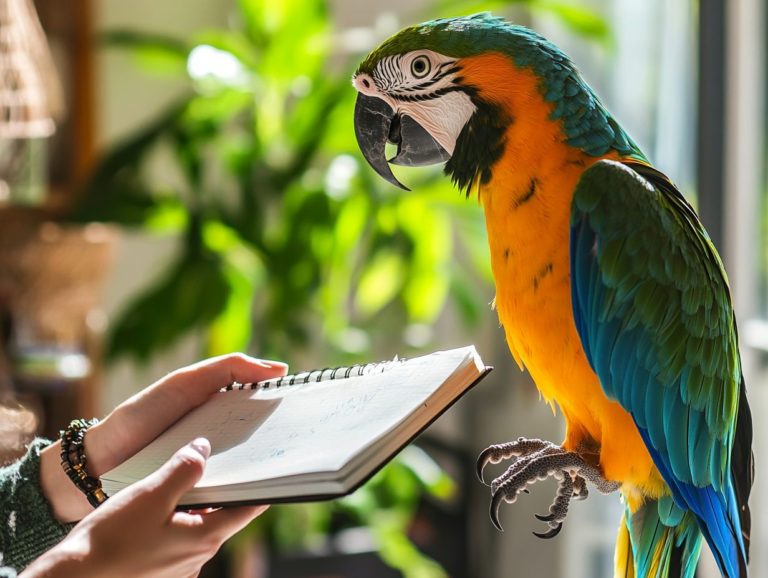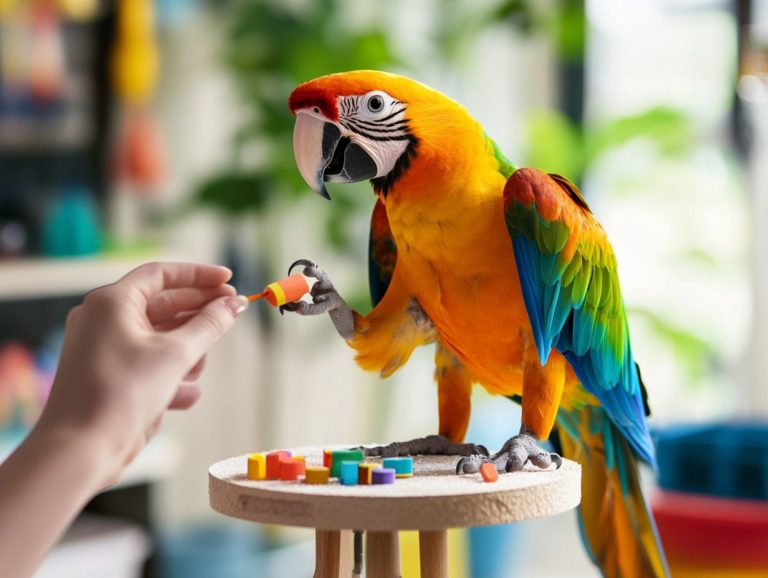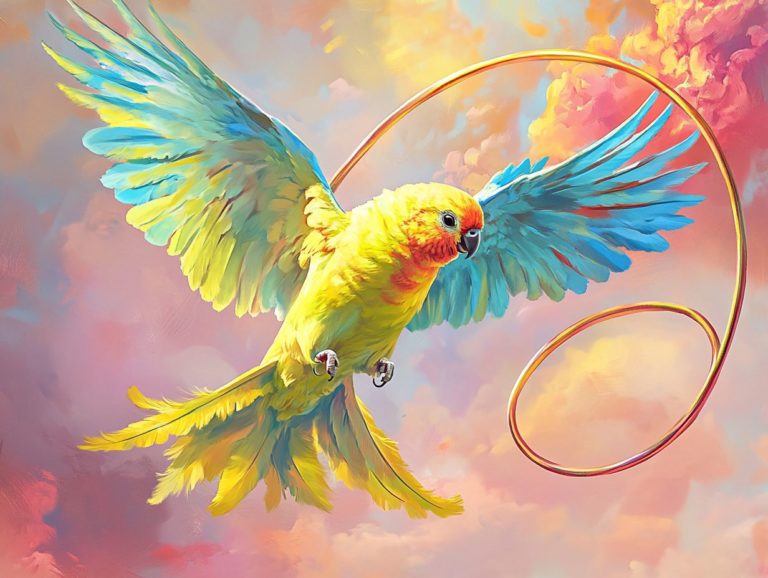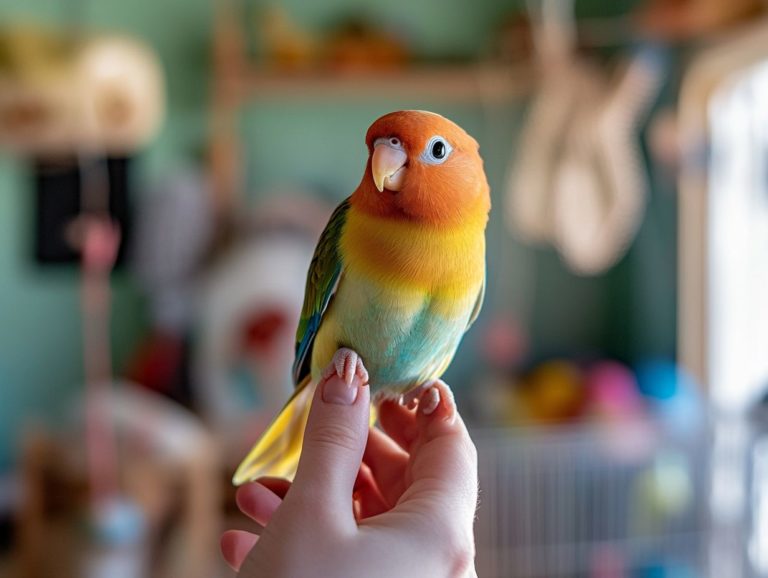5 Steps to Successfully Train Your Bird
Training your bird can be an incredibly rewarding experience, deepening your bond while enhancing their behavior. This guide will walk you through five essential steps for successfully training your feathered companion. You’ll start by understanding their species, establishing trust, and employing positive reinforcement techniques.
You’ll also learn about common mistakes to avoid, the myriad benefits of training, and advanced methods for those ready to elevate their skills. You ll also discover important safety precautions and effective ways to strengthen your bond. Start your exciting journey to become a skilled bird trainer today!
Contents
- Key Takeaways:
- 1. Understand Your Bird’s Species and Behavior
- 2. Establish Trust and Bonding
- 3. Start with Basic Commands
- 4. Use Positive Reinforcement Techniques
- 5. Be Consistent and Patient
- What Are Some Common Mistakes When Training a Bird?
- Frequently Asked Questions
- 1. What are the 5 steps to successfully train your bird?
- 2. How do I bond with my bird?
- 3. What does it mean to establish trust with a bird?
- 4. Can any bird be trained using these 5 steps?
- 5. How important is reinforcing good behavior during training?
- 6. Is training a one-time process, or does it require ongoing practice?
Key Takeaways:
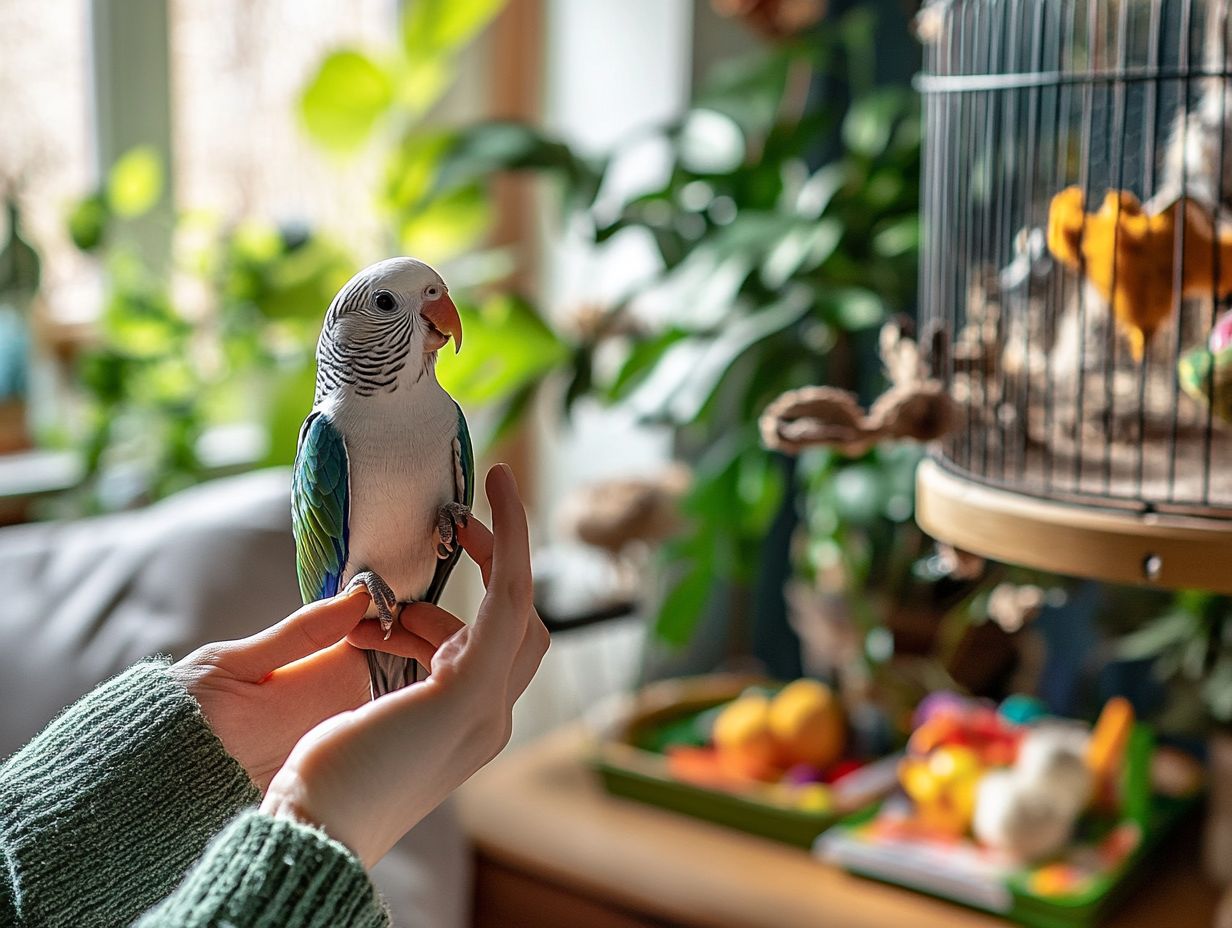
- Understanding your bird’s species and behavior is crucial for successful training.
- Building trust is the foundation for effective training.
- Start with basic commands and progress gradually.
1. Understand Your Bird’s Species and Behavior
Understanding your bird s species and behavior is essential for successful training. Each type of bird, such as Amazon parrots and macaws, has unique traits that shape how they learn.
For example, Amazon parrots thrive on social interactions and vocal mimicry, making your training sessions dynamic and engaging. In contrast, African greys may require a bit more patience due to their thoughtful nature. By recognizing these tendencies, you can personalize your training techniques to align with each bird’s characteristics.
Environmental factors also play a significant role in a bird’s learning ability. Consider factors like noise levels and opportunities for social interaction. A calm and enriching environment can vastly improve concentration and help reduce stress. Being attuned to behaviors, such as attention spans and response times, is crucial for crafting effective training strategies that resonate with your feathered companion.
2. Establish Trust and Bonding
Establishing trust and bonding with your pet bird is essential for nurturing a strong relationship. These social creatures thrive on companionship and positive interactions that build their confidence and attention toward you.
Engaging in quality activities whether that s simple play sessions or leisurely conversations can profoundly impact how your bird views its environment and its interactions with you. Pay close attention to your bird s body language; subtle signs like head tilting, wing flapping, or soft vocalizations can reveal its comfort level. By interpreting these cues accurately, you can create a nurturing space where your bird feels safe and understood.
This solid foundation enhances the training process and elicits better behavioral responses, as your bird develops a deeper sense of trust and connection with you.
3. Start with Basic Commands
Starting with basic commands is an essential step in training your pet bird, as it lays the groundwork for effective communication and enhances your bird’s responsiveness during sessions. For more guidance, check out the best training techniques for pet birds.
Engaging your feathered companion with simple commands like “step up” and “stay” not only strengthens your bond but also taps into their natural intelligence. To enhance your training sessions, consider using the top 5 toys for training your bird. Remember, repetition and consistency are key to successful training. By regularly practicing each command and employing positive reinforcement techniques such as treats or heartfelt praise, your bird will quickly learn to associate these actions with rewards.
This approach cultivates a positive learning environment that fosters trust and cooperation, making your future training sessions enjoyable and productive.
4. Use Positive Reinforcement Techniques
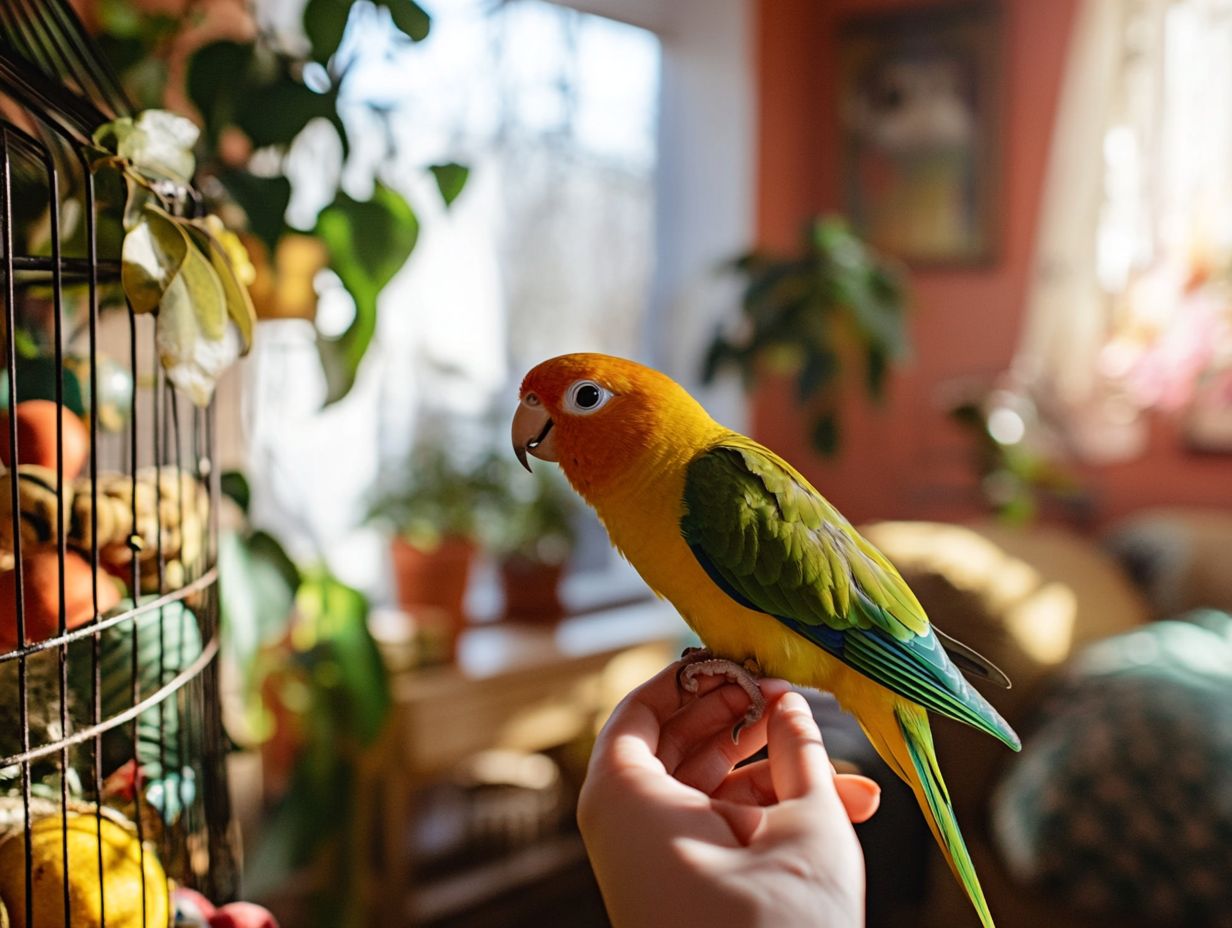
Positive reinforcement is one of the best ways to train a bird. Rewarding good behavior with treats and praise encourages learning.
Use various positive reinforcement methods. For example, offer small treats when your bird follows commands or use vocal praise to celebrate its achievements. To ensure your training sessions remain enjoyable, check out this guide on how to keep training fun for your bird. This motivates your feathered friend to engage in desired behaviors more consistently.
If your bird is too loud, rewarding moments of quietness with a favorite snack can reinforce that calm behavior. Simple praise, such as saying “good bird” or “well done,” creates a positive association. This makes it more likely that your bird will respond to commands in the future. Ultimately, this method creates an exciting, happy home for both you and your bird!
5. Be Consistent and Patient
Consistency and patience during training sessions are essential for developing your bird’s skills and building trust. For more guidance, check out these tips for training a timid bird. Repetition reinforces learning, ensuring your feathered friend feels secure and confident.
To maintain this consistency, establish clear commands and use the same cues in each session. Whether it s a simple gesture or a specific word, sticking to a routine helps your bird understand what is expected.
Short, focused training periods keep your bird engaged without overwhelming it, especially for younger or less experienced individuals. This approach prevents frustration and nurtures a deeper connection between you and your bird. To further enhance your bird’s transition, consider these 5 ways to make your adopted bird feel at home. Over time, this sets the stage for successfully mastering more advanced tricks and behaviors.
What Are Some Common Mistakes When Training a Bird?
Common mistakes in bird training can really hinder the learning process and lead to frustration. This often results in behavior problems that complicate training.
To truly nurture your bird’s potential, avoid using inconsistent commands. This confuses your feathered friend and stalls progress. Remember, harsh discipline can erode the trust that is essential for effective training.
Instead, embrace positive reinforcement techniques. Offering treats or praise right after your bird exhibits good behavior encourages them to repeat those actions. To further improve your training sessions, consider setting up a training area for your bird. Understanding your bird’s unique behavior patterns and communication cues will significantly enhance the training experience.
By cultivating a supportive and patient atmosphere, you forge a bond that leads to successful training outcomes and enriches your overall companionship.
What Are the Benefits of Training a Bird?
Training a bird brings many benefits, including enhanced mental stimulation, improved social interaction, and a deeper bond between you and your avian friend, significantly enriching your relationship.
Through engaging training sessions, your feathered companion can develop sharper cognitive skills as it learns to follow commands and respond to cues. Teaching your bird to mimic words or perform tricks challenges its intelligence and cultivates a gratifying sense of accomplishment.
This mental engagement is crucial for your bird s emotional well-being, reducing stress and boredom while encouraging playful behaviors. As you work closely during training, you establish a deeper channel of communication, fostering mutual understanding that strengthens your bond.
The joy of celebrating small victories in training further enhances your connection, transforming each interaction into a meaningful experience.
What Are Some Advanced Training Techniques?
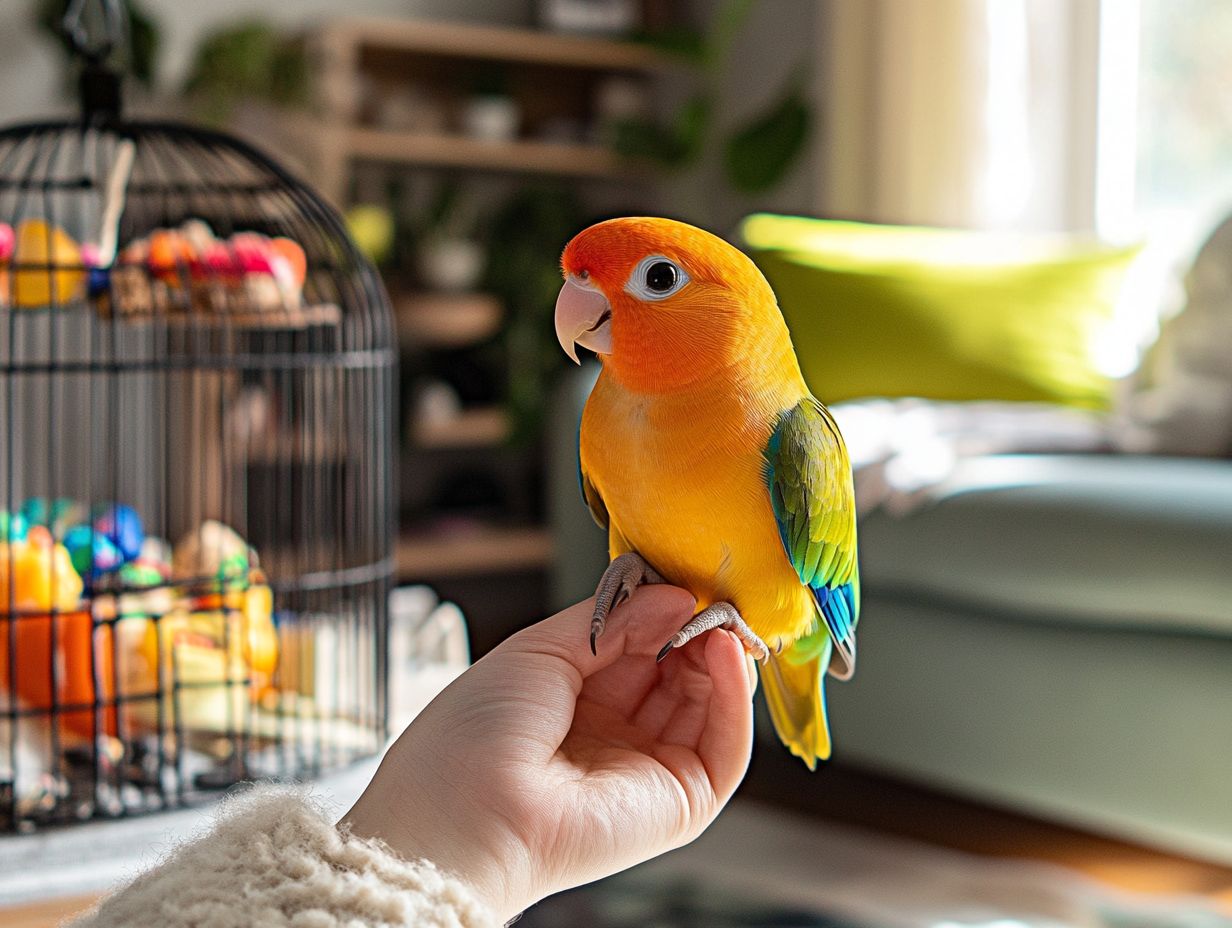
Advanced training techniques for birds, like teaching tricks or implementing flight training, present an exhilarating challenge for you and your feathered companions. These techniques enhance both their skills and the bond you share.
They go far beyond simple commands. While a basic command like “sit” serves as a solid foundation, advanced methods introduce complex tricks such as playing fetch or even executing aerial acrobatics. Take crows, for example; their intelligence allows them to solve puzzles and use tools, perfectly showcasing their remarkable problem-solving abilities.
Parrots, on the other hand, can learn to perform lively dances or mimic specific sounds on cue.
Advanced training sessions give your bird crucial mental stimulation. They also boost social interaction, making the experience rewarding for both of you!
How Can Training Help with Behavioral Issues?
Training is crucial for tackling behavioral issues in birds! Using rewards to encourage good behavior fosters trust and ensures your bird receives the attention and understanding it deserves. For new pet owners, following tips for transitioning your bird post-adoption can make a significant difference.
When you create a nurturing environment, you’ll often discover that challenges like excessive screaming, biting, or feather plucking can be effectively managed. Targeted training strategies not only help counter these behaviors but also enrich the overall bonding experience between you and your feathered friend.
It s important to recognize subtle cues in their body language. For example, a puffed-up chest or raised feathers may signal stress or discomfort.
Tuning into these signals allows you to respond appropriately and adjust your training approach. This cultivates a harmonious space that benefits both you and your avian companion. Engaging in social interaction during this process fosters a greater sense of trust.
What Are Some Safety Precautions to Keep in Mind?
Ensuring safety during your bird training sessions is essential. A secure environment prevents accidents and fosters a positive training experience for your pet bird, allowing them to truly thrive as they learn.
Safety is a priority, especially with younger birds who may be more fragile. To create a safe training space, minimize potential hazards like toxic plants or sharp objects.
Make sure the area is quiet and free from distractions that could startle your bird. Having a knowledgeable supervisor present can significantly enhance safety. They can monitor your bird’s well-being and provide valuable guidance.
Incorporating safe grooming practices is equally important. Regular checks for feather and beak health improve your bird s overall condition and help ensure they remain comfortable and focused during training. When you take these precautions, your bird is much more likely to absorb new skills effectively.
How Can a Trainer Bond with Their Bird?
You can bond effectively with your bird through dedicated social interaction and trust-building techniques. These establish a strong foundation for both training and companionship. The process of building this bond is essential in understanding your bird’s body language.
Engaging in specific bonding activities greatly enhances this relationship. For example, playtime allows your bird to explore its environment and build confidence. Grooming promotes physical well-being and deepens the emotional connection between you both.
Speaking to your bird in a calm and soothing voice fosters a sense of security and comfort, encouraging it to seek closeness. These consistent interactions help establish trust and enable effective communication, which is essential for successful training.
Ultimately, the bond you cultivate through these shared experiences leads to a harmonious partnership filled with mutual respect and understanding. This is essential for achieving successful advanced training with your bird.
Frequently Asked Questions
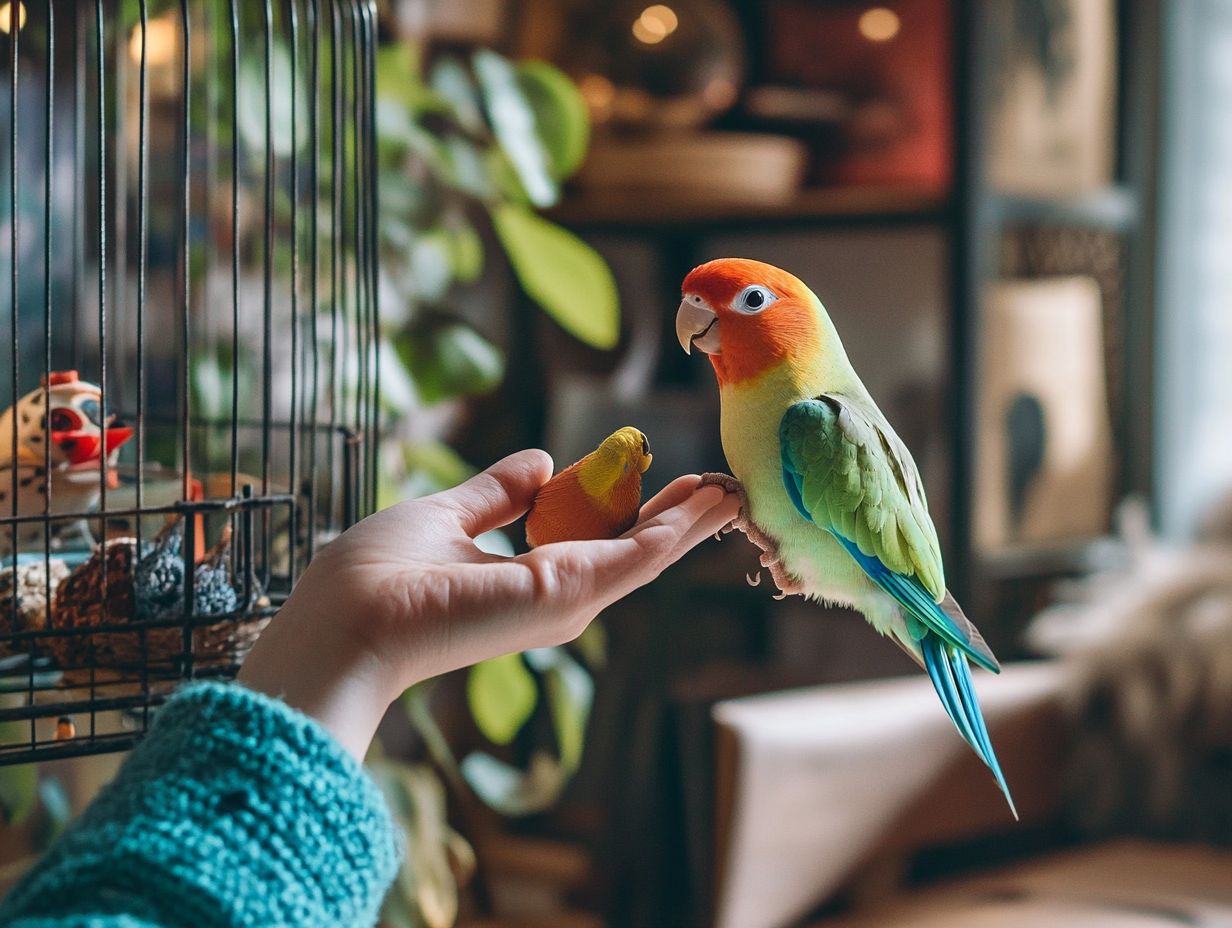
1. What are the 5 steps to successfully train your bird?
To train your bird successfully, bond with them daily. Establish trust, teach simple commands, reward good behavior, and practice regularly. For more guidance, check out these 5 steps to take after adopting a bird.
2. How do I bond with my bird?
Bonding involves daily interactions. Talk to your bird, offer treats, and create a safe, comfy space for them.
3. What does it mean to establish trust with a bird?
Establishing trust means creating a safe environment. Your bird should feel comfortable with you and be willing to learn.
4. Can any bird be trained using these 5 steps?
Most birds, like parrots and cockatiels, can be trained with 5 ways to build trust with your bird. Training methods may vary by species.
5. How important is reinforcing good behavior during training?
Praising good behavior is vital. It helps your bird recognize desirable actions and encourages them to repeat those behaviors.
6. Is training a one-time process, or does it require ongoing practice?
Training is an ongoing journey. Consistently practicing and reinforcing behaviors helps maintain your bird’s good habits.

